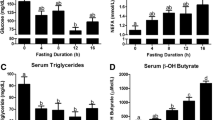Abstract
To test for a regulatory defect in adipose triacylglycerol (essential) fatty acid mobilization in lymphoma-bearing mice, free [1-14C]linoleic acid/mouse serum albumin was injectediv into lymphoma-bearing and control mice, adapted to a reversed light cycle, and studied in three dietary states in the dark period. Mean daily food intake decreased in mice with small and large tumor burdens. Plasma free fatty acid (FFA) oxidation rates, which approximate FFA mobilization rates, were estimated by multicompartmental analysis (CONSAM). Oxidation of linoleate to CO2 was reduced significantly (85%) inad libitum fed as compared to briefly fasted control mice but not in fedvs. fasted mice with large or small tumor burdens. However, plasma FFA oxidation rates to CO2 did not differ in briefly fasted tumor-bearing and pairfed control mice. When re-fed a 250-mg test meal, briefly fasted mice with small tumors suppressed plasma free linoleic acid oxidation, as did controls. During simulated night, mildly anorexic, tumor-bearing mice with small tumor burdens mobilized essential fatty acids much faster than controls. This could explain body fat loss. The abnormally rapid rates of FFA (free linoleic acid) mobilization at night probably result from anorexia rather than from inability of food to suppress fat mobilization.
Similar content being viewed by others
Abbreviations
- EAT:
-
Ehrlich ascites tumor
- EFA:
-
essential fatty acid(s)
- FCR:
-
fractional catabolic rate
- FFA:
-
free fatty acid(s)
- I.D.:
-
injected dose
- LMF:
-
lipid mobilizing factor(s)
- SAAM/CONSAM:
-
computer programs used for simulation analysis and modeling
- TB:
-
tumor-bearing
- TGFA:
-
triacylglycerol fatty acid(s)
- TNF:
-
tumor necrosis factor
- VLDL:
-
very low density lipoprotein
References
Kitada, S., Hays, E.F., and Mead, J.F. (1980)Lipids 15, 168–174.
Kitada, S., Hays, E.F., Mead, J.F., and Zabin, I. (1981)J. Cell Biochem. 20, 409–416.
Sauer, L.A., and Dauchy, R.T. (1988)Cancer Res. 48, 3106–3111.
Baker, N., Gan-Elepano, M., Guthrie, B.A., and Mead, J.F. (1989)Lipids 24, 1028–1034.
Kannan, R., Gan-Elepano, M., and Baker, N. (1990)Cancer Res. 50, 2221–2227.
Hays, E.F., Margaretten, N., and Swanson, S.K. (1982)J. Natl. Cancer Inst. 69, 1077–1082.
Baker, N., Sandborg, D., Morris, D., and Ookhtens, M. (1977)Cancer Res. 37, 2218–2225.
Riley, V. (1960)Proc. Soc. Exptl. Biol. Med. 104, 751–754.
Baker, N., Morris, D., and Sandborg, C. (1976)Lipids 11, 818–820.
Hron, W.T., and Menahan, L.A. (1981)J. Lipid Res. 22, 377–381.
Baker, N., Gan-Elepano, M., and Mead, J.F. (1987)Am. J. Physiol. 253, R746-R755.
Ookhtens, M., and Baker, N. (1979)Cancer Res. 39, 5118–5123.
Berman, M., and Weiss, M.F. (1978)SAAM, Manual, Department of Health, Education and Welfare Publication No. (NIH) 78-180. United States Government Printing Office, Washington, D.C.
Boston, R.C., Grief, P.C., and Berman, M. (1981)Comput. Programs Biomed. 13, 111–119.
Baker, N., Hill, V., and Ookhtens, M. (1978)Cancer Res. 38, 2372–2377.
Waterhouse, C., and Kemperman, J.H. (1971)Cancer Res. 17, 127–133.
Waterhouse, C., Baker, N., and Rostami, H. (1969)J. Lipid Res. 10, 487–494.
Patton, S., Shepard, H.M., Wilking, H., Lewis, G., Aggarwal, B.B., Eesalu, T.E., Gavin, L.A., and Grunfeld, C. (1986)Proc. Natl. Acad. Sci. USA 83, 8313–8317.
Beck, S.A., and Tisdale, M.J. (1987)Cancer Res. 47, 5919–5923.
Lanza-Jacoby, S., Lansey, S.C., Miller, E.E., and Cleary, M.P. (1984)Cancer Res. 44, 5062–5067.
Cerami, A., Ikeda, Y., Le Trang, N., Hotez, P.J., and Beutler, B. (1985)Immunology Letters 11, 173–177.
Oliff, A., Defeo-Jones, D., Boyer, M., Martinez, D., Kiefer, D., Vuocolo, G., Wolfe, A., and Socher, S. (1987)Cell 50, 555–563.
Stovroff, M.C., Fraker, D.L., Swedenborg, J.A., and Norton, J.A. (1988)Cancer Res. 48, 4567–4572.
Author information
Authors and Affiliations
About this article
Cite this article
Kannan, R., Gan-Elepano, M. & Baker, N. Anorexic contribution to increased linoleate mobilization and oxidation in lymphoma-bearing mice. Lipids 27, 117–123 (1992). https://doi.org/10.1007/BF02535810
Received:
Revised:
Accepted:
Issue Date:
DOI: https://doi.org/10.1007/BF02535810




